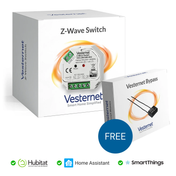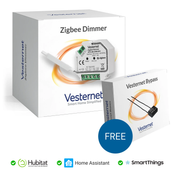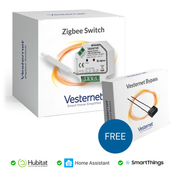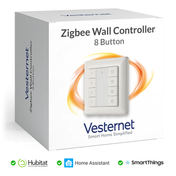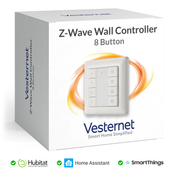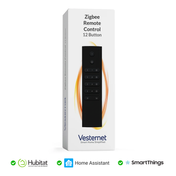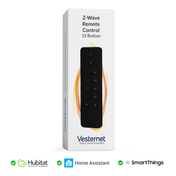How do Z-Wave Controllers and Devices Work?
Z-Wave is a very efficient wireless home automation technology. The network devices communicate with each other enabling you to easily manage all aspects of your automated home. Your heating system, security systems and lights can all be controlled as and when you like.
Z-Wave is also very versatile, there are a huge range of devices available that can meet any needs you may have, and you can make your system as small or as large as you like.
Z-Wave Device Basics

The Z-Wave system has three layers; radio, network and an application layer
These three layers work together to create a robust and reliable network that enables numerous nodes and devices to communicate with each other simultaneously.
For most of this article we’ll focus on the Application layer, which specifies how and why two nodes can communicate with each other.
In Z-Wave terminology controlling devices are called controllers, reporting devices are called sensors and controlled devices are called actuators. Even though there are hundreds of Z-Wave devices available on the market, nearly all of them can be categorised into one of these function groups:
-
Controllers - devices that control other Z-Wave devices
- Remote Controls - universal remote control (with IR) or dedicated Z-Wave Remote Control with special keys for network functions, group and/or scene control
- USB sticks and IP gateways to allow PC software to access Z-Wave networks. Gateways also allow remote access via the internet
-
Sensors - devices that report information by sending a digital or analogue signal
- Analogue Sensors - measure parameters like temperature, humidity and gas concentration
- Digital Sensors - door/glass breaking, motion detector and flood warning
-
Actuators - devices that switch digital (on/off for an electrical switch) or analogue signals (0 % … 100 % for a dimmer or blind control)
- Electrical Switches - plug-in modules for wall outlets or direct replacements for traditional wall switches (digital)
- Electrical Dimmers - plug-in modules or replacements for traditional wall switches/dimmers (analogue)
- Motor Control - open or close a door, window or blind or a venetian blind (analogue or digital)
- Electrical Display - provide visual feedback or an alert such as a siren, LCD panel, etc (digital)
- Thermostats controls - TRVs (Thermostat Radiator Valves) or floor heating controls (analogue or digital)
Z-Wave offers a huge range of different devices for all types of application
Command Classes
All communication within the Z-Wave network is organised into ‘Command Classes’. Command Classes are groups of commands and responses related to a certain function of a device.

Examples of different command classes
A normal on/off switch is referred to as a binary switch. The basic function of a binary switch is to be switched on and off. With a Z-Wave system it’s also possible to know the status of the switch, therefore a status request function and a status report function are also required.
The Command Class for a binary switch consists of three different function responses, commands or reports.
- Binary Switch – SET: sent from a controller to the switch to turn the switch on or off
- Binary Switch – GET: sent from the controller to the switch to request a report about the switching state
- Binary Switch – REPORT: sent from the switch back to the controller as a response to the Binary Switch – GET Command.
These three commands and responses are grouped and referred to as command class ‘Binary Switch’. If a certain Z-Wave device supports the command class ‘binary switch’ it should be able to deal with all these commands:
- Understands the SET command and set the switch accordingly
- Able to receive a GET command and respond with a correctly formatted report command
The Command Class - Basic
Command Classes represent the functions of a certain Z-Wave device. Each type of device will support different command classes - switches, dimmers, thermostats etc. all use different command classes.
To ensure Z-Wave devices can communicate with each other even when they don’t know the specific function of the other device, there is a special command class called “Basic”.
The ‘Basic’ command class consists of two commands and one response:
- SET - set a value between 0 and 255 (#0x00 …0xff)
- GET - ask the device to report a value
- REPORT - response to the GET command, reporting a value between 0 and 255 (0x00 … 0xff)
The unique feature of the ‘Basic’ command class is that every device interprets the ‘Basic’ commands depending on that device’s specific functionality.
For instance:
- A binary switch will switch on when receiving a value 255 and switch off when receiving a value of 0
- A thermostat may turn into a ‘convenience’ temperature mode when receiving value = 0 and an ‘energy saving’ mode for any other value
- A temperature sensor will issue a basic report and send an integer temperature value
- A door sensor will either send out a value = 0 in case the door is closed or a 255 when the door is open

Basic Command Class
The basic command class is the lowest common denominator of all Z-Wave devices. Every Z-Wave device supports the ‘Basic’ command class.
Device Classes
To allow inter-operability between different Z-Wave devices from different manufacturers, each device must include certain well-defined functions above and beyond the ‘Basic’ command class.
These requirements are called ‘Device Classes’. A device class refers to a typical device and defines which command classes that are mandatory for it to support.
Device classes are organised into a three-layer hierarchy:
- Every device must belong to a basic device class
- Devices can be further specified by assigning them to a generic device class
- Further functionality can be defined by assigning the device to a specific device class
Basic Device Class
The ‘Basic’ device class simply defines a device as a Controller, Slave or Routing Slave. Therefore every device belongs to one basic device class.
Generic Device Class
The ‘Generic’ device class defines the basic functionality that the devices will support as a controller or slave. Current ‘Generic’ device classes are:
- General controller (GENERIC_CONTROLLER)
- Static controller (STATIC_CONTROLLER)
- Binary switch (BINARY_SWITCH)
- Multi level switch (MULTI_LEVEL_SWITCH)
- Binary sensor (BINARY_SENSOR)
- Multilevel-Sensor (MULTILEVEL_SENSOR)
- Meter (METER)
- Input controller (ENTRY_CONTROL)
- Thermostat (THERMOSTAT)
- Window Blind controller (WINDOW_COVERING)
Specific Device Class
Assigning a ‘Specific’ device class to a Z-Wave device allows it to further specify its functionality. Each ‘Generic’ device class refers to a number of specific device classes. You can decide to assign a specific device class, however, it only makes sense if the device really supports all functions of a ‘Specific’ device class.
‘Specific’ device classes include:
- Setback Thermostat (SETBACK_THERMOSTAT) - specific device class of the generic device class “Thermostat“
- Multi-level Power Switch (MULTILEVEL_POWER_SWITCH) - specific device class of the generic device class Multi Level Switch
In case the Z-Wave device is assigned to a ‘Specific’ device class, it is required to support a set of command classes as functions of this ‘Specific’ device class.
These required command classes are called ‘Mandatory Command Classes’ and are individual to particular generic and specific device classes.
Above and beyond the mandatory device classes, Z-Wave devices can support further optional command classes.
A Z-Wave manufacturer is allowed to implement an unlimited number of optional device classes. However, if these device classes are implemented, the Z-Wave standard defines how these commands and functions are to be supported.

Optionally, recommended and mandatory Command Classes within a device class
The ‘Basic’, ‘Generic’ and, if available, ‘Specific’ device classes are announced by the device during Inclusion, using a ‘Node Information Frame’.
As well as the device classes, the Node information frame also announces all optional command classes of the included device. With this announcement, a controller can control and use an included Z-Wave device according to its functionality.

Different Implementations of a Device Class "Binary Power Switch" by different vendors
A Z-Wave device works according to the Z-Wave standard if:
- It belongs to a ‘Basic’ and a ‘Generic’ device class, and is able to report these classes on request using a Node Information Frame
- It supports all ‘Mandatory’ command classes
- ‘Basic’ and ‘Generic’ command classes - sending commands and reports as well as accepting and executing commands according to the specification
- ‘Specific’ device class (if selected) - all additional ‘Mandatory’ command classes of this specific device class must be supported
- In case optional command classes are implemented, these command classes need to be announced in the Node Information Frame on request and need to be supported according to the Z-Wave command class specifications.
Z-Wave defines a broad variety of command classes covering almost every aspect of home automation and control. Nevertheless, manufacturers may wish to implement further functionality not already defined in a command class specification.
The command class ‘Proprietary Function’ is defined to cover these needs. A ‘Proprietary Function’ would allow a manufacturer to implement specific functions that can then be used only by other devices supporting this proprietary function.
The use of a ‘Proprietary Function’ is subject to approval by the Z-Wave alliance certification authority and is requires extensive documentation. So far very few devices make use of this function. Typically, new requirements result sooner or later in an amendment to the existing standard, which makes this function part of the official standard and any proprietary extensions becomes obsolete.
Selection of Devices - Controllers
The selection of devices is always based on the desired functionality of the network. A network always consists either of a central remote control or a central static (fixed location) gateway for instance an IP gateway or as software on a PC.
It is recommended to use a static controller for a reliable Z-Wave network installation.
Using a remote (mobile) control as the only controller for a Z-Wave network is not recommended unless:
- There are only a few devices to be controlled (less than ten)
- No battery-operated devices are in the network
- No time dependent functions like closing the window blinds at a certain time of the day are required
Selection of Devices - Slaves
Portable dimmers and switches, also called “smart plugs” or “wall outlet plugs” are easy to choose. You just need to check that the device’s maximum switching capacity (load) is suitable for your appliance
Choosing wall switches is usually based on the aesthetic design, so that it complements existing switches or decor. Most switches have have the same industry-standard design as other wall outlets, wall switches, antenna, phone jacks and Ethernet outlets.
It’s also possible to turn existing ‘standard’ switches into Z-Wave switches by installing special insert. However, check the pattress (back box) depth before buying.
Z-Wave – The future of Energy Saving in the Home
Z-Wave home automation offers you a world of options to personalise your system so that it does what you need it to.
And by using a central static controller such as the VERA, you can easily pre-programme all of these instructions. VERA controls lamp modules, thermostats, in-wall light switches, power strips, alarm sensors, garage door openers, window blinds, and home theatre solutions.
The system can automatically change heating and lighting when you go to work, or you can go on holiday without those second thoughts, ‘did I leave the bathroom light on?’ or ‘did I turn the thermostat down?’
Z-Wave is an incredibly versatile technology supported by numerous manufacturers. Starting a Z-Wave system today, you can be safe in the knowledge that it will expand with your changing requirements and will continue to give you fantastic service for many years. More information on Z-Wave advantages is available in What is Z-Wave.
Vesternet is Europe’s leading home automation specialist, offering the widest range of Z-Wave products.



